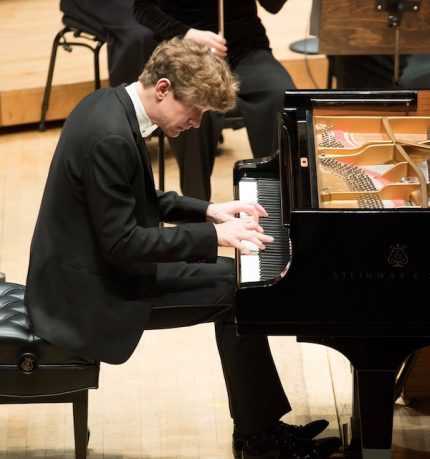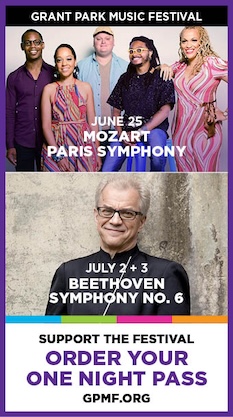An enjoyably varied night in Vienna from Honeck, CSO

The penultimate Chicago Symphony Orchestra program of 2019 looked like a decidedly odd mélange on paper: a contemporary work, a Mozart concerto and a second half devoted to polkas and waltzes by Johann Strauss Jr.—decidedly light fare for a CSO subscription concert.
But with Manfred Honeck on the podium Thursday night— one of the finest and most popular of CSO guest conductors— this Virtually Viennese evening proved hugely enjoyable and came off with surprising success.
But then maybe not so surprising. Honeck, music director of the Pittsburgh Symphony Orchestra, is a remarkably consistent conductor and he brought the same brand of incisive direction and bracing vitality Thursday night as on previous local stands. Further, the Austrian musician is steeped in the Viennese musical tradition, having played for years in the Vienna Philharmonic (as violinist and violist).
Finally, by all accounts Honeck continues to rank high on the short list of potential Riccardo Muti successors when the mercurial Italian music director’s contract is up in the spring of 2022. So, this week’s program offered a practical opportunity for Chicago audiences to hear Honeck tackle a contemporary work for the first time as well as some lighter Viennese rep.
Mason Bates continues to be the most performed of the younger generation of American composers. Still, his output is often inconsistent. During his four seasons as a CSO composer in residence (2010-15), one found Bates overworking the same devices (a folk or jazzy rhythmic riff passing from percussion to strings to winds) in music that felt increasingly tired and predictable.
Yet Bates’ Resurrexit, which led off the evening, presented one of the composer’s most compelling musical efforts in years.
Dedicated to Honeck and premiered by him with the Pittsburgh Symphony last year, Resurrexit effectively melds Bates’s populist style with the deeper spiritual inspiration of Christ’s resurrection. Following an opening quick upward flourish by the large orchestral forces, the music segues into a dark and searching section for woodwinds evoking a distinctly Middle Eastern atmosphere. A lamenting bass trombone solo—rendered by Charlie Vernon with rich tone and suffused feeling—reflects upon Christ’s death.
An Easter chant presents a more animated and optimistic section with the tempo accelerating amid copious, increasingly brilliant effects by the huge percussion battery. (Bates’ taste in exotic instrumentation is reflected in his use of the suspended “semantron”—which looked to be a large suspended wooden board, but what do I know?). As the music grows in confidence and affirmation, the Easter hymn takes flight in soaring resplendence over the whirling strings and percussion leading to a triumphant coda.
Honeck showed himself just as commanding in this Mason Bates work as in his previous local outings of Mozart, Beethoven and Mahler. The final section of Resurrexit was thrilling as much for Honeck’s balancing as for the energy and commitment of the playing—all of the orchestra sections and the kaleidoscopic array of percussion colors and timbres emerged with astounding clarity.
Honeck always brings keyboard collaborators steeped in the Viennese style and such was the case with Jan Lisiecki who made his CSO debut Thursday night with Mozart’s Piano Concerto No. 21 in C major, K.467.

The very tall Canadian showed himself a fine, elegant Mozartian with a light, breezy touch and crisp articulation. Yet he is clearly his own Mozart man—as revealed in his subtle phrasing and dynamic marking, and the lingering expression the pianist brought to the minor-key episodes.
Lisiecki also showed his individuality in his cadenza choices (Mozart’s have not survived). In the final movement he opted for Paul Badura-Skoda’s brief but quirky solo, and Lisiecki provided his own first-movement cadenza—a stylish mix of tradition with some neat bursts of bravura while staying within stylistic parameters
The young soloist also showed admirable professionalism dealing with an unfortunate array of sonic distractions coming at him from different directions. First, there were loud vocal exclamations, apparently from a handicapped patron on the main floor. Then a high, keening hearing aid obbligato began sounding in the balcony at the start of the Andante—one of the most rarefied passages in all music—and continued nearly throughout the rest of the movement. To his credit Lisiecki continued to play with unruffled poise and refinement.
The finale is one of the most witty and joyous of Mozart creations, and went like the wind in Lisiecki’s hands. With lightning back-and-forth between the soloist and the orchestra under Honeck’s alert direction, the concerto performance was rounded off in high-spirited fashion that was infectious and sheerly delightful.
As superb as his Mozart was, the pianist’s encore of Chopin’s Nocturne in C sharp minor, Op. posth., was finer still. Spacious and probing with daringly terraced dynamics, Lisiecki painted the searching nocturnal melancholy of this music with the utmost tonal sensitivity.
New Year’s Day 2020 came early this year in Chicago with the Johann Strauss Jr. second half. Despite reservations about the lightweight menu—as if CSO programming isn’t unadventurous enough—Strauss’s music was directed with such consummate flair by Honeck and played with such huge panache and vitality by the orchestra that it proved impossible to resist. Not everything has to be Mahler’s Ninth.
Brother Josef Strauss got one scheduled item with the Die Libelle (Dragonfly) polka, but the rest of the six works were all by Johann Jr.
The Overture to The Gypsy Baron set the tone with Honeck’s firmly pointed direction bringing both sonic heft and light-footed Viennese grace, accented by idiomatic fractional hesitation at the start of the waltz phrases. Honeck also brought out the lilting essence of the Voices of Spring waltz most winningly.
The only minor debit was that no CSO principal winds played in the Mozart concerto or any of the second half. (Clarinetist Stephen Williamson was the sole first-chair wind player in the house and he played only in the Bates.) That absence was felt in repertoire that benefits from an extra spark of musical personality.
In addition to coaxing robust contributions from percussion and brass, Honeck was inspired in putting across Strauss’s scoring ingenuity and humor. The Furioso polka was thrown off with a madcap Monty Python-esque tear of virtuosity, yet the transparency ensured that the little high violin squeaks were heard. Likewise, with the Im Krapfenwaldl polka (In Krapfen’s Woods), the jokey owl hoots delivered their rustic forest rim-shots, perfectly timed by assistant timpanist Vadim Karpinos to comical effect.
The presentation was in line with the Vienna Philharmonic tradition, with the orchestra getting their exercise Thursday as Honeck encouraged them to stand to acknowledge the applause after each three-minute item. There were also multiple curtain calls before a “surprise” encore, after several audience members had already streamed out.
The evening ended in highly offbeat fashion with Josef Strauss’s Feuerfest (Fireproof) polka. Karpinos was the soloist for this theatrical bonus: dressed in an apron as a forge worker, he wheeled out his metal percussion to the front of the stage as soloist.
Karpinos’s comic shtick as the bored foundryman—yawning, reading a newspaper and swigging from a champagne bottle in between his isolated metallic contributions—was a hoot. The CSO percussionist so inhabited the Viennese humor of this silliness that one wondered for a moment if Honeck had brought along an outside comic ringer from the Vienna Volksoper.
Even the most stone-faced CSO members couldn’t help laughing and breaking up at Karpinos’s antics as he tried to distract Honeck and repeatedly encouraged concertmaster Robert Chen to take a drink from his bottle.
The program will be repeated 8 p.m. Saturday. cso.org; 312-294-3000.
Posted in Performances


Posted Dec 13, 2019 at 3:53 pm by Frank Monnelly
Kudos to whomever came up with the idea for the shtick in the encore. Double kudos to Mr. Karpinos for its pitch perfect execution.
He stole the show.
Posted Jan 03, 2020 at 11:28 am by Geo.
By coincidence, Honeck’s current Pittsburgh contract is through 2022 as well. So if he wants to make a change, and Muti wants to step down from the CSO in 2022, the stars could align.
Honeck has done this Johann Strauss II second half with several orchestras now. I saw him conduct such a concert half in NYC a while back.